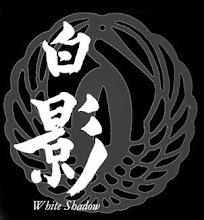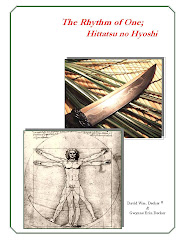 I had a young man (Zak) ask me to explain my fascination with the katana, or shinken. This is my reply to him. One of the most famous Japanese sayings is “ken shin ichi nyo,” the sword and the mind are one. But the warrior’s mind and spirit being one with his weapon cuts across all cultures, races, and times.
I had a young man (Zak) ask me to explain my fascination with the katana, or shinken. This is my reply to him. One of the most famous Japanese sayings is “ken shin ichi nyo,” the sword and the mind are one. But the warrior’s mind and spirit being one with his weapon cuts across all cultures, races, and times.A true warrior must understand the spirit within his weapons, whether that spirit is forged in or absorbed through the sweat and blood of its owner’s hands. It is not enough to be an efficient killer or a wild barbarian, which result from the mechanical use of the sword without the spiritual. Death comes to all of us but the real way of the warrior, the real bushido, is finding that middle ground and achieving a sense of balance.
 Zak, as you said, the katana is a razor, par excellent. But, as we mature in our understanding of Western martial arts we also find that the better broad swords were well balanced and razor sharp too, not the crude armor mashers we originally thought. One of the main differences tactically is that the katana was both sword and shield to its master, unlike the Westerner who blocked attacks with a shield held in his left hand.
Zak, as you said, the katana is a razor, par excellent. But, as we mature in our understanding of Western martial arts we also find that the better broad swords were well balanced and razor sharp too, not the crude armor mashers we originally thought. One of the main differences tactically is that the katana was both sword and shield to its master, unlike the Westerner who blocked attacks with a shield held in his left hand.Many schools in America that teach Kenjutsu (combat swordsmanship) disparage the use of the blade for blocking, especially edge-wise, because they say the very hard edge will chip, ruining the sword. While it is true the blade may chip, not blocking is simply an old wives tales. Once when 80+ year old Japanese sensei Yagyu Nobuharu was asked about that his response was very pragmatic. Basically he said: Yes my sword blade may get chipped but if I do not block a cut I might get killed. When the battle is over, if I survive, I look around for a nicer sword. If I don’t survive, then it doesn’t matter.
To the samurai the katana blade was imbued with its own spirituality and soul. The mounts (however plain or fancy) were of a distant secondary importance. I think it was a major concession for the blade maker to punch a hole in the tang for the bamboo pin which holds the handle and guard on the blade. If the mystical or spiritual doesn’t appeal to you then I would revert to the original argument, the katana is one of the most capable cutters in the history of the world. It is a ruthlessly efficient killer capable of cleanly severing a human body completely through in one stroke. The metallurgical and tempering qualities are unique, and although Damascus and Wootz were also great sword making materials none of them surpassed the differentially tempered Japanese blade. A well designed and executed katana is exquisitely balanced for one or two handed use. By comparison most modern katana are over sized, over weight, with fat handles and crude mounts.
In use, a sword (like a fighting knife) has two primary functions, cutting or thrusting. A Japanese sword may also be used for deflecting or blocking as I mentioned. Different schools of swordmaking had different degrees of curvature forged into their blades based on the techniques taught by the schools of instruction. For example, if a school liked to use the thrust it would gravitate toward a straighter blade than a school whose principal attack was a slash. Makes sense right? While many people say that a thrust is more lethal than a cut, that rationale does not apply if the cut is so massive as to dismember or bisect the opponent. I don’t know if any of this actually answered Zak’s question. It may be a subliminal thing that is felt rather than a logical thing that can be argued or rationalized. Either way the katana is a fearsome, elegant, and sublime weapon. The photos are by Bugei trading Company of my Peace Sword.






2 comments:
Dave, I'll be the first to admit that I am not a swordsman, but I have had a deep fascination with katanas for years now. Beautiful and absolutely devastating weapons. I think your writeup explained part of my subconscious fascination with them.
A true warrior learns how to put his sword down, before he ever learns how to pick one up.
Post a Comment